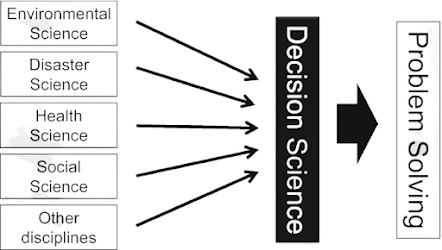The primary goal of Decision Sciences is to provide a systematic approach to understanding and improving decision-making in organizations and other contexts. It involves collecting and analyzing data, developing models and algorithms, and applying quantitative techniques to optimize decision outcomes.
Here are some key components and applications of Decision Sciences:
Data Analysis: Decision Sciences heavily relies on data analysis techniques to extract insights and patterns from large datasets. This involves using statistical methods, data mining, machine learning, and other analytical approaches to gain a deeper understanding of the problem at hand.
Decision Modeling: Decision Sciences involves creating models that represent decision problems and their associated variables, constraints, and objectives. These models help in structuring decision-making processes and provide a framework for evaluating different alternatives.
Optimization: Decision Sciences often includes optimization methods to find the best possible solution among a set of available options. Optimization techniques aim to maximize or minimize specific objectives while considering various constraints.
Forecasting: Decision Sciences utilizes forecasting techniques to predict future outcomes based on historical data and trends. These forecasts can aid decision-makers in planning and allocating resources effectively.
Risk Analysis: Decision Sciences incorporates risk analysis to evaluate and quantify uncertainties associated with decision-making. By considering potential risks and their probabilities, decision-makers can make more informed choices and develop strategies to mitigate adverse outcomes.
Operations Research: Operations research is a subfield of Decision Sciences that focuses on improving the efficiency and effectiveness of operations within organizations. It involves mathematical modeling, optimization, and simulation techniques to solve complex operational problems.
Supply Chain Management: Decision Sciences plays a crucial role in supply chain management by optimizing logistics, inventory management, and distribution networks. It helps in improving supply chain efficiency, reducing costs, and enhancing customer satisfaction.
Financial Decision Making: Decision Sciences techniques are often applied in financial decision-making processes, such as portfolio optimization, risk management, and investment analysis. It assists in making data-driven financial decisions and maximizing returns.
Healthcare Management: Decision Sciences can be applied in healthcare management to optimize resource allocation, patient flow, scheduling, and treatment planning. It helps healthcare providers improve patient outcomes, reduce costs, and enhance operational efficiency.
Decision Support Systems: Decision Sciences involves the development and implementation of decision support systems (DSS). These systems integrate data, models, and algorithms to assist decision-makers in evaluating alternatives, exploring scenarios, and making informed decisions.
Simulation Modeling: Decision Sciences utilizes simulation modeling to mimic real-world systems and analyze their behavior under different conditions. Simulation models help in understanding complex systems, predicting outcomes, and evaluating the impact of different decisions.
Strategic Planning: Decision Sciences provides tools and techniques for strategic planning, helping organizations define their goals, identify opportunities, and develop action plans. It enables decision-makers to align their decisions with long-term objectives and evaluate the potential outcomes.
Market Research and Consumer Behavior: Decision Sciences incorporates market research methods to gather data on consumer behavior, preferences, and market trends. By analyzing this data, organizations can make better-informed decisions related to product development, pricing, marketing strategies, and customer satisfaction.
Project Management: Decision Sciences techniques can be applied to project management, aiding in project planning, resource allocation, risk assessment, and scheduling. It helps project managers optimize project outcomes, manage uncertainties, and improve project success rates.
Quality Management: Decision Sciences plays a role in quality management by providing tools and methodologies for process improvement, quality control, and performance measurement. It helps organizations identify areas for improvement, optimize processes, and enhance product or service quality.
Environmental Decision Making: Decision Sciences can be applied to environmental decision-making processes, such as natural resource management, energy planning, and environmental impact assessment. It assists in evaluating different alternatives, considering environmental factors, and making sustainable decisions.
Human Resources Management: Decision Sciences techniques can be utilized in human resources management for workforce planning, talent acquisition, performance evaluation, and employee scheduling. It helps organizations optimize their human capital and make data-driven decisions regarding workforce management.
Government and Public Policy: Decision Sciences has applications in government and public policy domains. It aids policymakers in analyzing policy options, evaluating the potential impact of decisions, and optimizing resource allocation to address societal challenges effectively.
Supply Chain Analytics: Decision Sciences incorporates supply chain analytics to optimize supply chain operations, enhance visibility, and improve overall efficiency. It involves analyzing supply chain data to identify bottlenecks, optimize inventory levels, reduce lead times, and improve customer satisfaction.
Customer Relationship Management: Decision Sciences techniques can be applied to customer relationship management (CRM) to analyze customer data, segment customers, and develop personalized marketing strategies. It helps organizations understand customer preferences, anticipate their needs, and enhance customer satisfaction and loyalty.
These are just a few examples of the wide range of applications and areas where Decision Sciences can be employed. The field continues to evolve with advancements in data analysis, technology, and computational methods, enabling more sophisticated decision-making processes across various industries and sectors.




No comments:
Post a Comment